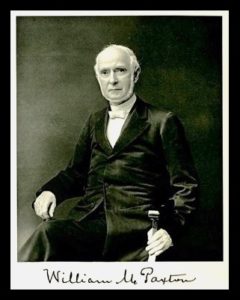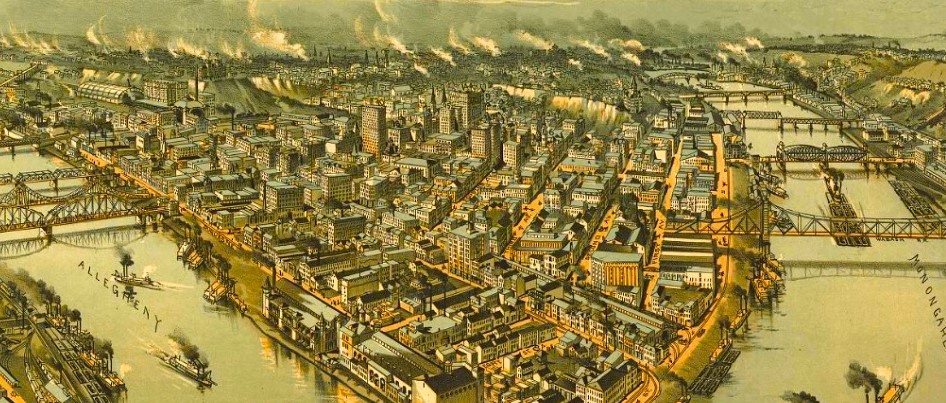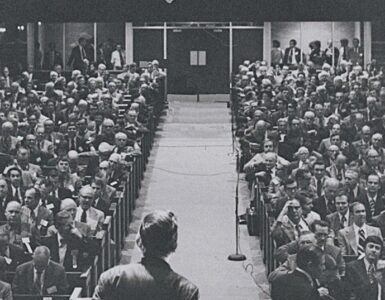 When B. B. Warfield delivered the memorial message for William M. Paxton in Miller Chapel at Princeton Seminary he said of his friend and colleague that “Dr. Paxton’s power always lay more in what he was than in what he did, and the best of all sermons was the sermon he preached by his life” (236). What an assessment of his fellow faculty member from the Lion of Princeton. Dr. Warfield had witnessed many of the twenty years Paxton taught and during the course of the memorial message it is clear that his fond memories were multiplied by those of many other Princetonians.
When B. B. Warfield delivered the memorial message for William M. Paxton in Miller Chapel at Princeton Seminary he said of his friend and colleague that “Dr. Paxton’s power always lay more in what he was than in what he did, and the best of all sermons was the sermon he preached by his life” (236). What an assessment of his fellow faculty member from the Lion of Princeton. Dr. Warfield had witnessed many of the twenty years Paxton taught and during the course of the memorial message it is clear that his fond memories were multiplied by those of many other Princetonians.
William Miller Paxton was born of Scots-Irish descent in Adams County, Pennsylvania June 7, 1824. His father, Col. James Dunlop Paxton worked manufacturing iron at Maria Furnace and his mother was a daughter of the Hon. William Miller. When Mrs. Paxton suffered an extended period of poor health, Col. Paxton moved the family to be near her family. Young William was educated locally before attending the recently established Pennsylvania College (currently Gettysburg College) where he graduated in 1843 with the intention of studying law. He chose to live at Caledonia Iron Works so he could read law with Judge George Chambers of Chambersburg. However, when William professed faith in Christ and united with the Falling Spring Presbyterian Church in 1845, it appears he concurrently perceived God’s call to the ministry. The next month he was taken under care of the Presbytery of Carlisle before moving to Princeton, New Jersey, for ministerial education.
William Paxton’s fellow students observed their classmate’s practices and commented that he was an industrious and painstakingly persistent student. He worked many hours at his studies and was an especially gifted, organized, and disciplined speaker. Later in life, he said of his student years at the seminary that
The class to which I belonged heard Dr. Archibald Alexander’s lectures upon Didactic Theology as well as those of Dr. Hodge. Dr. Hodge gave us a subject with massive learning, in its logical development, in its beautiful balance and connection with the whole system. Dr. Alexander would take the same subject and pierce it with a javelin, and let the light shine through it. His aim was to make one point and nail it fast (219).
Paxton studied to be a preacher but as Warfield observed he had a particular type of pulpit ministry in mind because “the real end of his study of doctrine was that he might become a doctrinal preacher.” But Paxton did not want to be what he described as “a theological grinder” whose procedure involved crushing and pulverizing truth between two logical millstones, and then presenting it grain by grain as if the bread of heaven was scarce.”(219-20). It was most important in Paxton’s thinking that he communicate Scripture with simplicity and doctrinal precision while maintaining sensitivity to the unique requirements of any congregation to which he preached (i.e. a simpler message for a congregation with less education, etc.).
He was diligent and skilled in his preparation and delivery of sermons, so much so that when he completed studies at Princeton there were several churches that showed interest in calling him as pastor. However, he returned to the area of Pennsylvania he was most familiar with when he went to the Greencastle Church immediately after graduating seminary in 1848 and was ordained and installed in October. He was succeeding T. V. Moore who had recently moved to First Presbyterian Church in Richmond, Virginia. From Greencastle Paxton relocated to the First Presbyterian Church of Pittsburgh beginning in January 1851. During his ministry, church membership nearly doubled. He continued in Pittsburgh not only as a pulpit minister but also as a teacher at Western Seminary. He became the seminary’s fifth faculty member with his field for instruction sacred rhetoric. The seminary was struggling for funds, so he provided his services without salary for his entire tenure from 1860 to 1872.
Shortly after beginning the Pittsburgh ministry, he married Hester V. B. Wickes who died with their child during delivery after only two years of marriage. In 1855, he married Caroline Sophia Denny who was a member of the First Church congregation. The couple would have three sons and four daughters. Unfortunately, their oldest son developed asthma when he was five years old and the smoke and soot of Pittsburgh’s industries aggravated his condition. After fourteen years of ministry and teaching, the family needed to move to a city with a less threatening atmosphere for their son.
Once it was known that Rev. Paxton was looking to leave Pittsburgh he had many offers and settled on the First Presbyterian Church in New York. He was installed February 1, 1866. The Pennsylvanian found ministry in the city different from that in Pittsburgh because it involved considerable work as an administrator while in Pittsburgh his labors were predominately centered around the pulpit. The New York ministry was busy with him serving on boards for local charities, in his denomination, and for home and foreign missions. The move east and his proximity to Princeton led to him becoming a director of the seminary beginning in 1866, then he became a trustee of Princeton College beginning the next year. He continued his divinity teaching in New York by lecturing on homiletics in Union Seminary, 1872-1875.
In 1883, Dr. Paxton moved from New York to Princeton to fill the Chair of Ecclesiastical, Homiletical, and Pastoral Theology left vacant by the resignation of A. T. McGill. It was not an easy decision to leave First Church because of his love for preaching. Shortly after beginning teaching in the seminary he had occasions of homesickness for the pastoral ministry just as other faculty, such as J. W. Alexander, experienced during his seminary teaching. Paxton published several lectures and sermons over the years of his life along with a review article titled, “The Call to the Ministry,” in the first issue of The Presbyterian Review. Warfield mentions that he personally saw some thirty written items including Paxton’s “elaborate scheme of Division of Sermons,” which he allowed to be printed for use by his seminary students only (235, more of a syllabus than a publication). Dr. Paxton served the seminary for twenty years until his weakening constitution and the advice of his physicians forced him to retire from teaching at the end of the 1901-1902 academic year. William Miller Paxton died November 28, 1904 from a stroke he suffered two weeks earlier. He was buried in the Princeton Cemetery.
Over the many years of his life he was honored often. Jefferson College granted him the D.D. in 1860. He served as a commissioner to the General Assembly in 1860, 1862, 1870, and 1881, and he was moderator of the meeting in Madison, Wisconsin, in 1880. His retiring moderator’s sermon the next year was from Isaiah 52:1, Awake, awake; put on thy strength, O Zion. In the fall of 1880 he attended the Second General Council of the Presbyterian Alliance which met in Philadelphia for its sessions in the Academy of Music in the evenings, and during the days in Horticultural Hall which was left from the 1876 United States Centennial celebration. At the Presbyterian Alliance, he was appointed to present the opening sermon which was delivered using Matthew 8:11 for his passage.
And I say unto you, That many shall come from the east and west, and shall sit down with Abraham, and Isaac, and Jacob, in the kingdom of heaven.
Barry Waugh
Sources—The header titled “Pittsburgh, Pennsylvania” dates to 1902 and is from the Library of Congress Digital Collection of World Digital Library images; the smoke of the city’s industry can be seen in the background still present thirty years after the Paxtons moved east. I don’t believe their is any kinship connection between the Miller kin of Paxton and the Samuel Miller family of Princeton. Additional portraits and PDF copies of some of his works are available on the Log College Press site in the entry, “William Miller Paxton (1824-1904).” Paxton’s sermon to the Presbyterian Alliance is provided in an edited version in Nevin, Presbyterian Encyclopedia, pages 639-43. The parenthetical page numbers in the biography refer to B. B. Warfield’s memorial found in The Princeton Theological Review, April 1905, 213-37. The Necrological Reports of Princeton Theological Seminary, 1905, was also helpful. The Centennial Volume of the First Presbyterian Church of Pittsburgh Pa., 1784-1884, has much material about Paxton. The picture of Paxton seated with cane and signature is an edited snapshot (his signature is now centered) from In Memoriam, William Miller Paxton, D.D., LL.D., 1824-1904, Funeral and Memorial Discourses, New York, 1905.





